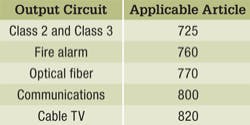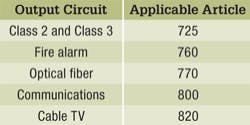From the March, 2012 Issue of Cabling Installation & Maintenance Magazine
A new article in the NEC’s Chapter 8 was created to accommodate fiber-optic service to the customer premises.
By Stanley Kaufman, CableSafe
The National Electrical Code is published by the National Fire Protection Association with revisions on a three-year schedule. The 2011 NEC, which replaces the 2008 NEC, was released by NFPA in August 2010. There were many changes of interest to manufacturers, installers and users of communications cable and connectivity products. (NFPA 70, NFPA, National Fire Protection Association, National Electrical Code and NEC are trademarks of the National Fire Protection Association.)
This is the final article in a series of nine articles, contributed on behalf of the Communications Cable and Connectivity Association (CCCA; www.cccassoc.org), concerning those relevant changes in the NEC.
The eight preceding articles covered the following.
- Introduction to the NEC, its scope and organization
- Changes in types and installation rules for data/comm raceways
- Changes in the permitted applications of data/comm cables in air-handling spaces
- Changes in the wiring rules for data/comm cables in riser applications
- Introduction of cable routing assemblies
- Data/comm cable applications
- Data/comm cable installation requirements
- Data/comm cable installations in a computer room
This article deals with a new article in Chapter 8 (Communications) of the 2011 NEC, Article 840, Premises-Powered Broadband Communications Systems.
Article 840 was created to accommodated FiOS (fiber-optic service), which brings an optical fiber to the customer premises and derives telephone, television and Internet service through an optical network terminal, or ONT. Creation of a new article was necessary because the scope of Article 770, Optical Fiber Cables and Raceways, only covers “the installation of optical fiber cables, raceways, and cable routing assemblies,” consequently the installation requirements for the ONT could not be inserted into Article 770. Use of Article 800 was a possibility, but Article 800 defers to Article 770 for optical fiber cable installation.
Article 830 in the 2008 NEC covers Network-Powered Broadband Communications. Article 840, a new article in the 2011 NEC, covers Premises-Powered Broadband Communications.
The scope of Article 830 states that it “covers network-powered broadband communications systems that provide any combination of voice, audio, video, data, and interactive services through a network interface unit” (NIU). The scope of Article 840 states that it “covers premises-powered optical fiber-based broadband communications systems that provide any combination of voice, video, data, and interactive services through an optical network terminal.”
The key difference between Articles 830 and 840 is that communications cable providing network-powered communications services provides power to an interface unit, whereas the communications cable providing premises-powered communications services is unpowered and the interface unit (called an ONT) is powered locally.
Because of the powering, Article 830 has many requirements that are not found in the telephone article (Article 800) or in the cable TV article (Article 820) in Chapter 8. On the other hand, Article 840 uses an optical fiber cable to deliver the services, so there are no power issues at all. The network-powered communications in Article 830 are provided through a NIU unit while the premises-powered communications in Article 840 are provided through an ONT. An ONT is a type of NIU.
Both Article 830 and Article 840 refer to other articles for the output circuits of the NIU or ONT, as indicated in the table.
Author’s disclaimer: This paper, provided by the Communications Cable and Connectivity Association (CCCA), is offered for general information and educational purposes. It is not offered, intended, nor should it be relied upon as legal advice. The paper does not set forth the views of any member or any other party, nor may it be taken as such. CCCA makes no warranty regarding the accuracy of the information provided in this paper, and expressly disclaims any implied warranties and any liability for use of the paper or reliance on views expressed in it. CCCA does not endorse, approve or certify any information set forth in this paper, nor does it guarantee the accuracy, completeness, efficacy, timeliness or correct sequencing of such information. Use of the paper and the views expressed in it is voluntary, and reliance on it should only be undertaken after an independent review of its accuracy, completeness, efficacy and timeliness, and based on the individual facts and circumstances of a user.
Stanley Kaufman, Ph.D. is principal of CableSafe Inc. and a consultant to the Communications Cable and Connectivity Association (CCCA; www.cccassoc.org).
Past CIM Articles

